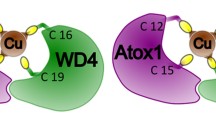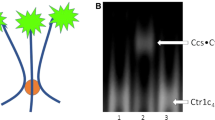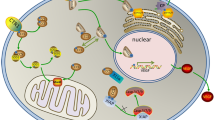Abstract
After Ctr1-mediated copper ion (Cu) entry into the human cytoplasm, chaperones Atox1 and CCS deliver Cu to P1B-type ATPases and to superoxide dismutase, respectively, via direct protein–protein interactions. Although the two Cu chaperones are presumed to work along independent pathways, we here assessed cross-reactivity between Atox1 and the first domain of CCS (CCS1) using biochemical and biophysical methods in vitro. By NMR we show that CCS1 is monomeric although it elutes differently from Atox1 in size exclusion chromatography (SEC). This property allows separation of Atox1 and CCS1 by SEC and, combined with the 254/280 nm ratio as an indicator of Cu loading, we demonstrate that Cu can be transferred from one protein to the other. Cu exchange also occurs with full-length CCS and, as expected, the interaction involves the metal binding sites since mutation of Cu-binding cysteine in Atox1 eliminates Cu transfer from CCS1. Cross-reactivity between CCS and Atox1 may aid in regulation of Cu distribution in the cytoplasm.





Similar content being viewed by others
References
Achila D, Banci L, Bertini I, Bunce J, Ciofi-Baffoni S, Huffman DL (2006) Structure of human Wilson protein domains 5 and 6 and their interplay with domain 4 and the copper chaperone HAH1 in copper uptake. Proc Natl Acad Sci USA 103(15):5729–5734
Allen S, Badarau A, Dennison C (2012) Cu(I) affinities of the domain 1 and 3 sites in the human metallochaperone for Cu, Zn-superoxide dismutase. Biochemistry 51(7):1439–1448
Arnesano F, Banci L, Bertini I, Ciofi-Baffoni S, Molteni E, Huffman DL, O’Halloran TV (2002) Metallochaperones and metal-transporting ATPases: a comparative analysis of sequences and structures. Genome Res 12(2):255–271
Banci L, Bertini I, Ciofi-Baffoni S, Chasapis CT, Hadjiliadis N, Rosato A (2005) An NMR study of the interaction between the human copper(I) chaperone and the second and fifth metal-binding domains of the Menkes protein. FEBS J 272(3):865–871
Banci L, Bertini I, Cantini F, Rosenzweig AC, Yatsunyk LA (2008) Metal binding domains 3 and 4 of the Wilson disease protein: solution structure and interaction with the copper(I) chaperone HAH1. Biochemistry 47(28):7423–7429
Banci L, Bertini I, Cantini F, Massagni C, Migliardi M, Rosato A (2009) An NMR study of the interaction of the N-terminal cytoplasmic tail of the Wilson disease protein with copper(I)-HAH1. J Biol Chem 284(14):9354–9360
Banci L, Bertini I, Cantini F, Kozyreva T, Massagni C, Palumaa P, Rubino JT, Zovo K (2012) Human superoxide dismutase 1 (hSOD1) maturation through interaction with human copper chaperone for SOD1 (hCCS). Proc Natl Acad Sci USA 109(34):13555–13560
Banci L, Cantini F, Kozyreva T, Rubino JT (2013) Mechanistic aspects of hSOD1 maturation from the solution structure of Cu(I) -loaded hCCS domain 1 and analysis of disulfide-free hSOD1 mutants. ChemBioChem 14(14):1839–1844
Berger S, Braun S (2004) 200 and more NMR experiments. A practical course. Wiley-VHC, Weinheim
Boal AK, Rosenzweig AC (2009) Structural biology of copper trafficking. Chem Rev 109(10):4760–4779
Festa RA, Thiele DJ (2011) Copper: an essential metal in biology. Curr Biol 21(21):R877–R883
Harris ED (2003) Basic and clinical aspects of copper. Crit Rev Clin Lab Sci 40(5):547–586
Harrison MD, Jones CE, Dameron CT (1999) Copper chaperones: function, structure and copper-binding properties. J Biol Inorg Chem 4(2):145–153
Hatori Y, Lutsenko S (2013) An expanding range of functions for the copper chaperone/antioxidant protein Atox1. Antioxid Redox Signal 19:945–957
Huffman DL, O’Halloran TV (2001) Function, structure, and mechanism of intracellular copper trafficking proteins. Annu Rev Biochem 70:677–701
Jones JA, Wilkins DK, Smith LJ, Dobson CM (1997) Characterization of protein unfolding by NMR diffusion measurements. J Biomol NMR 10:199–203
Kim BE, Nevitt T, Thiele DJ (2008) Mechanisms for copper acquisition, distribution and regulation. Nat Chem Biol 4(3):176–185
Lamb AL, Torres AS, O’Halloran TV, Rosenzweig AC (2001) Heterodimeric structure of superoxide dismutase in complex with its metallochaperone. Nat Struct Biol 8(9):751–755
Maryon EB, Molloy SA, Kaplan JH (2013) Cellular glutathione plays a key role in copper uptake mediated by human copper transporter 1. Am J Physiol Cell Physiol 304(8):C768–C779
Niemiec MS, Weise CF, Wittung-Stafshede P (2012) In vitro thermodynamic dissection of human copper transfer from chaperone to target protein. PLoS One 7(5):e36102
Niemiec MS, Dingeldein AP, Wittung-Stafshede P (2014) T versus D in the MTCXXC motif of copper transport proteins plays a role in directional metal transport. J Biol Inorg Chem 19:1037–1047
Nilsson L, Aden J, Niemiec MS, Nam K, Wittung-Stafshede P (2013) Small pH and salt variations radically alter the thermal stability of metal-binding domains in the copper transporter, Wilson disease protein. J Phys Chem B 117(42):13038–13050
O’Halloran TV, Culotta VC (2000) Metallochaperones, an intracellular shuttle service for metal ions. J Biol Chem 275(33):25057–25060
Ohrvik H, Thiele DJ (2014) How copper traverses cellular membranes through the mammalian copper transporter 1, Ctr1. Ann N Y Acad Sci 1314:32–41
Pope CR, De Feo CJ, Unger VM (2013) Cellular distribution of copper to superoxide dismutase involves scaffolding by membranes. Proc Natl Acad Sci USA 110(51):20491–20496
Puig S, Thiele DJ (2002) Molecular mechanisms of copper uptake and distribution. Curr Opin Chem Biol 6(2):171–180
Robinson NJ, Winge DR (2010) Copper metallochaperones. Annu Rev Biochem 79:537–562
Tanner JE (1970) Use of the stimulated echo in nmr diffusion studies. J Chem Phys 52(5):2523–2526
Wong PC, Waggoner D, Subramaniam JR, Tessarollo L, Bartnikas TB, Culotta VC, Price DL, Rothstein J, Gitlin JD (2000) Copper chaperone for superoxide dismutase is essential to activate mammalian Cu/Zn superoxide dismutase. Proc Natl Acad Sci USA 97(6):2886–2891
Xiao Z, Wedd AG (2002) A C-terminal domain of the membrane copper pump Ctr1 exchanges copper(I) with the copper chaperone Atx1. Chem Commun (Camb) 6:588–589
Acknowledgments
The Swedish Natural Research Council, the Knut and Alice Wallenberg Foundation, the Göran Gustafsson Foundation, the Kempe Foundation and Umeå University provided financial support. MK was supported by a postdoctoral fellowship from the DFG (KO-4687/1-1). We thank Erik Björn (Umeå University) for performing ICP-MS.
Author information
Authors and Affiliations
Corresponding author
Additional information
Svenja Petzoldt and Dana Kahra: Shared first authors.
Electronic supplementary material
Below is the link to the electronic supplementary material.
Rights and permissions
About this article
Cite this article
Petzoldt, S., Kahra, D., Kovermann, M. et al. Human cytoplasmic copper chaperones Atox1 and CCS exchange copper ions in vitro. Biometals 28, 577–585 (2015). https://doi.org/10.1007/s10534-015-9832-1
Received:
Accepted:
Published:
Issue Date:
DOI: https://doi.org/10.1007/s10534-015-9832-1




